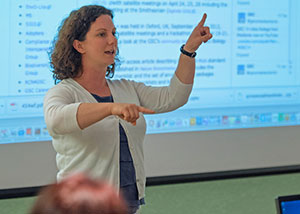You are here
Mysteries of the Super-Deep: How Tiny Creatures Are Thriving Hundreds of Feet below the Seafloor
You’ve probably wondered about the exotic life forms that live deep on the ocean floor. But you may not have realized there’s a whole living, thriving ecosystem of organisms that live as much as 500 feet below the ocean floor.
 Jennifer Biddle, Ph.D., assistant professor of marine biosciences at the University of Delaware’s College of Earth, Ocean, and Environment, will give a free public talk about her explorations and discoveries of microorganisms that live deep beneath the seafloor in 5 million-year-old sediment. Her talk is at 7 p.m. on Thursday, May 8, at the Vey Conference Center at Doernbecher Children’s Hospital, 11th floor, 3181 S.W. Sam Jackson Park Road, Portland, OR.
Jennifer Biddle, Ph.D., assistant professor of marine biosciences at the University of Delaware’s College of Earth, Ocean, and Environment, will give a free public talk about her explorations and discoveries of microorganisms that live deep beneath the seafloor in 5 million-year-old sediment. Her talk is at 7 p.m. on Thursday, May 8, at the Vey Conference Center at Doernbecher Children’s Hospital, 11th floor, 3181 S.W. Sam Jackson Park Road, Portland, OR.
These tiny organisms, which can survive thousands of years, are unlike any other species that live on the earth’s surface. It’s taken over a decade of study, but scientists are beginning to understand what these “intraterrestrials” do and how they live, deep in the subsurface of the seafloor.
Progress has been enabled by “next-generation” technologies, such as high throughput sequencing (a faster and more accurate way to determine an organism’s DNA sequence), which are now allowing scientists like Dr. Biddle to directly study the identity and activity of organisms in this completely unknown environment—below the ocean floor—that occupies a huge part of our planet.With these tools, Dr. Biddle and her colleagues seek to understand how geological and biological processes interact in these deep environments, and to explore possible applications of the microbes found at those depths.
The current thinking is that microbes below the ocean floor mostly sleep: their growth is very slow and their activities are hard to detect. But because of the huge volume they occupy and the large time span they have to act, they might be able to affect the environment and society in significant ways. For example, could these microbes help solve energy problems, or be used to clean up contaminants that affect our health and quality of life?
Dr. Biddle’s public talk is part of the national Ocean Leadership Distinguished Lecture Series, and is co-hosted by the OHSU Institute of Environmental Health and the OHSU-led National Science Foundation Science & Technology Center for Coastal Margin Observation & Prediction.






